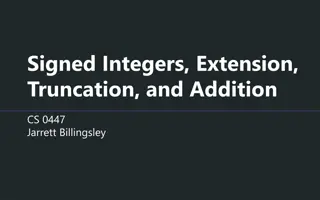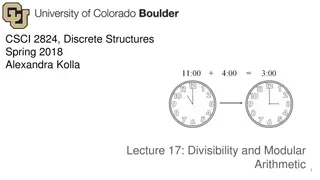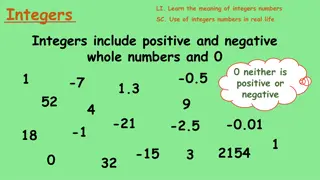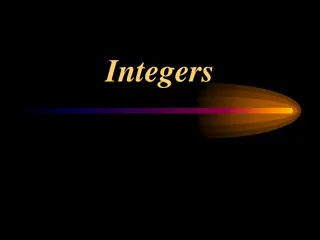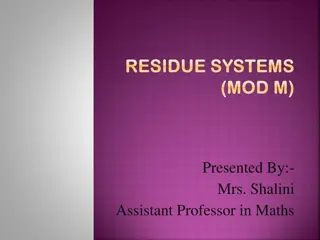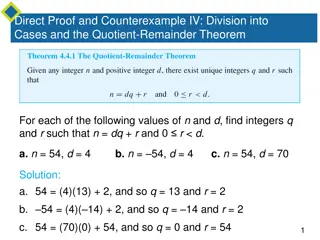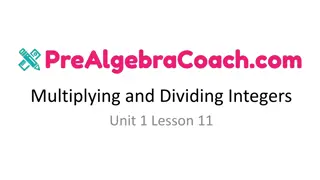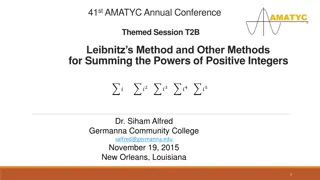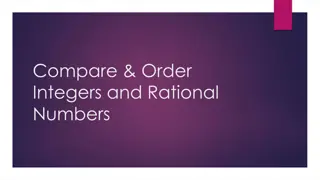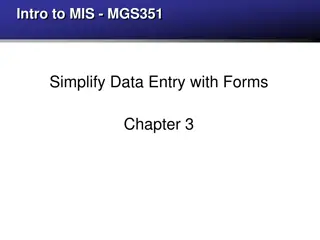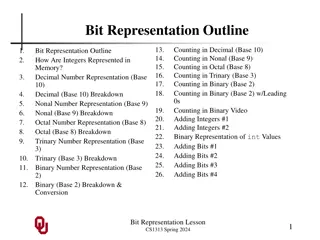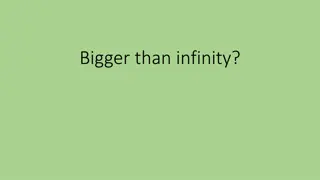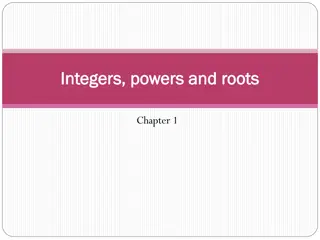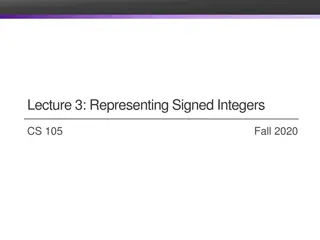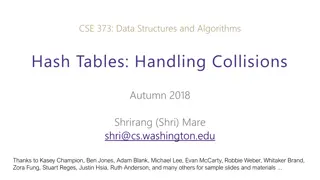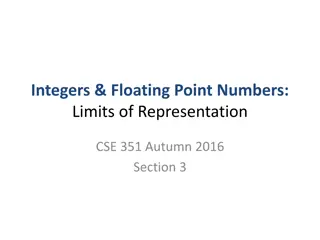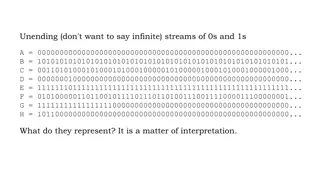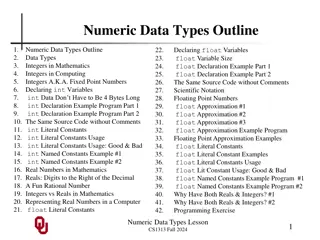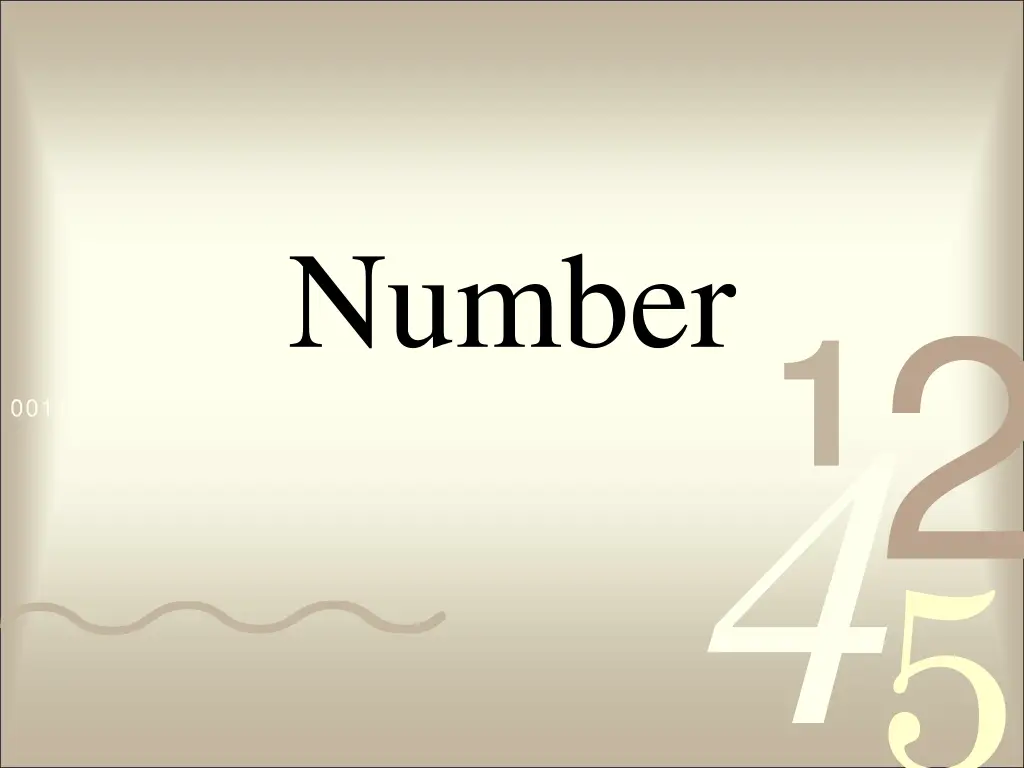
Understanding Numbers: Multiples, Factors, Prime Numbers, and Decimals
Explore the world of numbers with information on multiples, factors, prime numbers, and decimals. Learn how to find multiples, common factors, prime factors, and perform operations with decimals. Enhance your mathematical knowledge with this comprehensive guide.
Download Presentation

Please find below an Image/Link to download the presentation.
The content on the website is provided AS IS for your information and personal use only. It may not be sold, licensed, or shared on other websites without obtaining consent from the author. If you encounter any issues during the download, it is possible that the publisher has removed the file from their server.
You are allowed to download the files provided on this website for personal or commercial use, subject to the condition that they are used lawfully. All files are the property of their respective owners.
The content on the website is provided AS IS for your information and personal use only. It may not be sold, licensed, or shared on other websites without obtaining consent from the author.
E N D
Presentation Transcript
Number 42 5 1 3 0011 0010 1010 1101 0001 0100 1011
Counting Numbers - Also known as Natural numbers = 1, 2, 3, 4, 5... 0011 0010 1010 1101 0001 0100 1011 Multiples 42 5 - Achieved by multiplying the counting numbers by a certain number e.g. List the first 5 multiples of 6 6 1 6 2 6 3 6 12 18 24 Common Multiples 1 30 3 - Are multiples shared by numbers e.g. List the common multiples of 3 and 5 Multiples of 3: Common Multiples of 3 and 5: - The lowest common multiple (LCM) is the lowest number in the list e.g. The LCM of 3 and 5 is: 15 3,6,9,12, 15, ... Multiples of 5: 15, ... 5,10,15, 20, 25, ...
Factors 0011 0010 1010 1101 0001 0100 1011 - Are all of the counting numbers that divide evenly into a number - Easiest to find numbers in pairs e.g. List the factors of 20 1, Common Factors 42 5 2, 4, 5, 10, 20 1 3 - Are factors shared by numbers e.g. List the common factors of 12 and 28 Factors of 12: Common Multiples of 12 and 28: - The highest common factor (HCF) is the highest number in the list e.g. The HCF of 3 and 5 is: 4 1,2, 3, 4, 6, 12 Factors of 28: 1, 2,4 1, 2, 4, 7, 14, 28
Prime Numbers Note: 1 is NOT a prime number and 2 is the only EVEN prime number. - Have only 1 and itself as factors 0011 0010 1010 1101 0001 0100 1011 e.g. List the first 5 prime numbers 2, 3, 5, 7, 11 Prime Factors 42 5 1 - All numbers can be made by multiplying only prime numbers - Can be written as a Prime Factor tree. e.g. Write 50 as a product of prime numbers (factors) 50 3 When listing prime factors, list all repeats too. 2 25 5 5 50 as a product of primes is: 2 5 5
Decimals - Also known as decimal fractions 0011 0010 1010 1101 0001 0100 1011 - Place values of decimals are very important to know. - There are two parts to numbers, the whole number part and fraction part. Whole number 42 5 Fraction part 1 Thousands Hundreds Tens Ones Tenths Hundredths Thousandths 3
1. ADDING DECIMALS - Use whatever strategy you find most useful e.g. a) 2.7 + 4.8 = 7.5 b) 3.9 + 5.2 = 9.1 0011 0010 1010 1101 0001 0100 1011 c) 23.74 + 5.7 = 29.44 d) 12.8 + 16.65 = 29.45 42 5 2. SUBTRACTING DECIMALS - Again use whatever strategy you find most useful e.g. a) 4.8 2.7 = 2.1 1 b) 5.2 3.9 = 1.3 3 c) 23.4 - 5.73 = 17.67 d) 16.65 12.8 = 3.85 3. MULTIPLYING DECIMALS - Again use whatever strategy you find most useful a) 0.5 9.24 = 4.62 b) 2.54 3.62 = 9.1948 One method is to firstly ignore the decimal point and then when you finish multiplying count the number of digits behind the decimal point in the question to find where to place the decimal point in the answer
4. DIVIDING DECIMALS BY WHOLE NUMBERS - Whole numbers = 0, 1, 2, 3, 4, ... - Again use whatever strategy you find most useful a) 8.12 4 = 2.03 b) 74.16 6 = 12.36 0011 0010 1010 1101 0001 0100 1011 c) 0.048 2 = 0.024 d) 0.0056 8 = 0.0007 42 5 e) 2.3 5 = 0.46 f) 5.7 5 = 1.14 1 3 5. DIVIDING BY DECIMALS - It is often easier to move the digits left in both numbers so that you are dealing with whole numbers a) 18.296 0.04 457.4 1829.6 4 = b) 2.65 0.5 26.5 5 = 5.3
6. ROUNDING DECIMALS i) Count the number of places needed AFTER the decimal point ii) Look at the next digit - If it s a 5 or more, add 1 to the previous digit 0011 0010 1010 1101 0001 0100 1011 - If it s less than 5, leave previous digit unchanged iii) Drop off any extra digits 42 5 e.g. Round 6.12538 to: a) 1 decimal place (1 d.p.) Next digit = 2 1 b) 4 d.p. Next digit = 8 3 = leave unchanged = 6.1 = add 1 = 6.1254 The number of places you have to round to should tell you how many digits are left after the decimal point in your answer. i.e. 3 d.p. = 3 digits after the decimal point. When rounding decimals, you DO NOT move digits - ALWAYS round sensibly i.e. Money is rounded to 2 d.p.
Integers -5 -4 -3 -2 -1 0 1 2 3 4 5 0011 0010 1010 1101 0001 0100 1011 1. ADDING INTEGERS - One strategy is to use a number line but use whatever strategy suits you i) Move to the right if adding positive integers ii) Move to the left if adding negative integers e.g. 42 5 1 a) -3 + 5 = 2 b) -5 + 9 = 4 3 c) 1 + -4 = -3 d) -1 + -3 = -4 2. SUBTRACTING INTEGERS - One strategy is to add the opposite of the second integer to the first e.g. a) 5 - 2 = b) 4 - - 2 = 3 4 + 2 = 6 c) 1 - -6 = 1 + 6 = 7 - For several additions/subtractions work from the left to the right a) 2 - -8 + -3 = 10 + -3 = 7 b) -4 + 6 - -3 + -2 = 2 - -3 + -2 = 5 + -2 = 3
3. MULTIPLYING/DIVIDING INTEGERS - If both numbers being multiplied have the same signs, the answer is positive - If both numbers being multiplied have different signs, the answer is negative e.g. b) -5 -3 = 0011 0010 1010 1101 0001 0100 1011 a) 5 3 = 15 15 c) -5 3 = - 15 42 5 d) 15 3 = BEDMAS 5 e) -15 -3 = 5 f) 15 -3 = -5 1 3 - Describes order of operations B E D M A S ubtraction rackets xponents ivision ultiplication ddition (Also known as powers/indices) e.g. 4 (5 + -2 6) = 4 (5 + -12) = 4 (-7) = -28 Work left to right if only these two Work left to right if only these two
POWERS - Show repeated multiplication e.g. 0011 0010 1010 1101 0001 0100 1011 a) 3 3 3 3 = 34 b) 22 = e.g. 6 squared = 62 2 2 2 e.g. 4 cubed = 43 - Squaring = raising to a power of: - Cubing = raising to a power of: 42 5 3 = 6 6 = 36 = 4 4 4 = 64 1 1. WORKING OUT POWERS e.g. a) 33 = = 27 3 On a calculator you can use the xy or ^ button. 3 3 3 b) 54 = 5 5 5 5 = 625 2. POWERS OF NEGATIVE NUMBERS a) -53 = = -125 If using a calculator you must put the negative number in brackets! -5 -5 -5 b) -64 = -6 -6 -6 -6 = 1296 With an ODD power, the answer will be negative With an EVEN power, the answer will be positive
SQUARE ROOTS - The opposite of squaring e.g. The square root of 36 is 6 because: 6 6 = 62 = 36 0011 0010 1010 1101 0001 0100 1011 e.g. a) 64 = 8 13 b) 169 = 42 5 - On the calculator use the button or x button e.g. a) 10 = 3.16 (2 d.p.) 1 3 - Other roots can be calculated using the x button or x y button e.g. 4 1296 = 4 shift x 1296 = 6 This is because 6 6 6 6 = 64 And 64 =1296
FRACTIONS - Show how parts of an object compare to its whole e.g. Fraction shaded = 1 0011 0010 1010 1101 0001 0100 1011 4 42 5 1 1. SIMPLIFYING FRACTIONS - Fractions must ALWAYS be simplified where possible - Done by finding numbers (preferably the highest) that divide exactly into the numerator and denominators of a fraction 3 e.g. Simplify a) 5 = 10 5 5 1 2 b) 6 = 9 3 3 2 3 c) 45 = 60 5 5 3 3 9 12 = 3 4
2. MULTIPLYING FRACTIONS - Multiply numerators and bottom denominators separately then simplify. e.g. Calculate: 0011 0010 1010 1101 0001 0100 1011 a) 3 1 5 6 = 3 30 = 1 10 - If multiplying by a whole number, place whole number over 1. e.g. Calculate: = 3 1 5 6 3 3 b) 3 2 4 5 = 3 2 4 5 2 = 6 20 2 = 3 10 42 5 1 3 a) 3 5 20 = 3 5 20 1 b) 2 15 3 = 2 15 3 1 = 3 5 20 1 5 = 2 15 3 1 3 = 15 20 5 = 3 4 = 30 3 3 = 10 1 (= 10)
3. RECIPROCALS - Simply turn the fraction upside down. e.g. State the reciprocals of the following: = 5 0011 0010 1010 1101 0001 0100 1011 a) 3 5 3 b) 4 = 4 1 = 1 4 42 5 1 4. DIVIDING BY FRACTIONS - Multiply the first fraction by the reciprocal of the second, then simplify e.g. Simplify: = 2 3 3 = 2 4 3 3 3 a) 2 3 3 4 4 b) 4 3 5 = 4 3 5 1 = 4 5 = 4 1 5 3 1 3 = 8 9 = 4 15
5. ADDING/SUBTRACTING FRACTIONS a) With the same denominator: - Add/subtract the numerators and leave the denominator unchanged. Simplify if possible. e.g. Simplify: = 3 + 1 0011 0010 1010 1101 0001 0100 1011 a) 3 + 1 5 5 5 = 4 5 b) With different denominators: - Multiply denominators to find a common denominator. - Cross multiply to find equivalent numerators. - Add/subtract fractions then simplify. b) 7 - 3 8 8 = 7 - 3 8 = 4 8 4 = 1 2 4 42 5 1 3 e.g. Simplify: a) 1 + 2 4 5 = 4 5 5 1 + 4 2 b) 9 3 10 4 = 10 4 4 9 - 10 3 = 5 + 8 20 = 13 20 = 36 30 40 = 6 40 2 = 3 20 2
6. MIXED NUMBERS - Are combinations of whole numbers and fractions. a) Changing fractions into mixed numbers: - Divide denominator into numerator to find whole number and remainder gives fraction . 0011 0010 1010 1101 0001 0100 1011 e.g. Change into mixed numbers: a) 13 = 6 6 b) Changing mixed numbers into improper fractions: - Multiply whole number by denominator and add denominator. e.g. Change into improper fractions: a) 3 = 4 4 = 19 4 21 b) 22 = 5 42 42 5 5 1 3 4 4 + 3 b) 1 = 3 6 3 + 1 3 = 19 3 4 6
- To solve problems change mixed numbers into improper fractions first. e.g. 11 2 = 2 3 1 2 + 1 2 3 + 2 0011 0010 1010 1101 0001 0100 1011 2 3 2 = 3 8 2 3 = 24 6 = 4 1 42 5 Note: All of the fraction work can be done on a calculator using the a b/c button 1 (= 4) 3 7. RECURRING DECIMALS - Decimals that go on forever in a pattern - Dots show where pattern begins (and ends) and which numbers are included e.g. Write as a recurring decimals: a) 2 3 = 0.66666... b) 2 11 = 0.181818... c) 1 7 = 0.142857142... = 0.6 = 0.18 = 0.142857
8. FRACTIONS AND DECIMALS a) Changing fractions into decimals: - One strategy is to divide numerator by denominator e.g. Change the following into decimals: 0.4 0011 0010 1010 1101 0001 0100 1011 a) 2 = 5 b) 5 = 6 0.83 42 5 b) Changing decimals into fractions: - Number of digits after decimal point tells us how many zero s go on the bottom e.g. Change the following into fractions: a) 0.75 = 75 100 to simplify! = 3 4 9. COMPARING FRACTIONS - One method is to change fractions to decimals e.g. Order from SMALLEST to LARGEST: 1 2 2 4 2 5 3 9 0.5 0.4 0.6 0.4 1 3 b) 0.56 = 56 100 = 14 25 Don t forget ( 4) ( 4) Again ab/c button can be used 2 5 4 9 1 2 2 3
ESTIMATION 0011 0010 1010 1101 0001 0100 1011 - Involves guessing what the real answer may be close to by working with whole numbers - Generally we round numbers to 1 significant figure first 42 5 1 e.g. Estimate a) 4.986 7.003 = 3 5 7 = 35 b) 413 2.96 = 400 3 = 1200
PERCENTAGES - Percent means out of 100 1. PERCENTAGES, FRACTIONS AND DECIMALS 0011 0010 1010 1101 0001 0100 1011 a) Percentages into decimals and fractions: - Divide by (decimals) or place over (fractions) 100 and simplify if possible 42 5 e.g. Change the following into decimals and fractions: a) 65% = 0.65 = 65 100 = 13 20 1 100 b) 6% 100 = 0.06 ( 2) c) 216% 100 = 2.16 ( 4) = 6 100 = 3 50 = 216 100 = 54 25 ( 5) 3 (= 4 ) 25 2 b) Fractions into percentages: - Multiply by 100 e.g. Change the following fractions into percentages: a) 2 = 2 100 5 1 = 200 5 = 40% b) 5 = 5 100 4 1 = 500 4 = 125% c) 3 = 3 100 7 1 = 300 7 = 42.86% 5 4 7
c) Decimals into percentages: - Multiply by 100 e.g. Change the following decimals into percentages: 0011 0010 1010 1101 0001 0100 1011 a) 0.26 100= 26% b) 0.78 100= 78% c) 1.28 100= 128% 2. PERCENTAGES OF QUANTITIES - Use a strategy you find easy, such as finding simpler percentages and adding, or by changing the percentage to a decimal and multiplying 42 5 1 e.g. Calculate: 3 a) 47.5% of $160 10% = 16 5% = 8 2.5% = 4 Therefore 45% = 16 4 + 8 + 4 b) 75% of 200 kg = 0.75 200 = 150 kg = $76
4. ONE AMOUNT AS A PERCENTAGE OF ANOTHER - A number of similar strategies such as setting up a fraction and multiplying by 100 exist. e.g. Paul got 28 out of 50. What percentage is this? (each mark is worth 2%) 0011 0010 1010 1101 0001 0100 1011 100 50 = 2 28 2 = 56% e.g. Mark got 39 out of 50. What percentage is this? 39 50 42 5 100 = 78% 1 5. WORKING OUT ORIGINAL QUANITIES - Convert the final amount s percentage into a decimal. - Divide the final amount by the decimal. e.g. 16 is 20% of an amount. What is this amount 20% as a decimal = 0.2 3 To spot these types of questions, look for words such as pre , before or original Amount = 16 0.2 = 80 e.g. A price of $85 includes a tax mark-up of 15%. Calculate the pre-tax price. Final amount as a percentage = 100 + 15 =115 Final amount as a decimal = 1.15 Pre-tax price = 85 1.15 = $73.91
4. INCREASES AND DECREASES BY A PERCENTAGE a) Either find percentage and add to or subtract from original amount e.g. Carol finds a $60 top with a 15% discount. How much does she pay? 10% = 6 15% = $9 Therefore she pays = 60 - 9 0011 0010 1010 1101 0001 0100 1011 5% = 3 = $51 42 5 e.g. A shop puts a mark up of 20% on items. What will be the selling price for an item the shop buys for $40? 0.2 40= $8 Therefore the selling price = 40 + 8 1 = $48 3 b) Or use the following method: 100 + % 100 a) Increase $40 by 20% 40 100 + 20 100 = 40 120 100 = 40 1.2 = $48 Decreased Amount Increased Amount b) Decrease $60 by 15% 60 100 - 15 100 = 60 85 100 = 60 0.85 = $51 100 - % 100
5. PERCENTAGE INCREASE/DECREASE - To calculate percentage increase/decrease we can use: Percentage increase/decrease = decrease/increase 100 0011 0010 1010 1101 0001 0100 1011 original amount 42 5 e.g. Mikes wages increased from $11 to $13.50 an hour. 1 a) How much was the increase? 13.50 - 11 = $2.50 b) Calculate the percentage increase 2.50 11 100= 22.7% (1 d.p.) 3 e.g. A car originally brought for $4500 is resold for $2800. What was the percentage decrease in price? = 4500 - 2800 Percentage Decrease = 1700 Decrease 100 = $1700 4500 = 37.8% (1 d.p.) To spot these types of questions, look for the word percentage
GST - Is a tax of 12.5% - To calculate GST increase/decreases use: 0011 0010 1010 1101 0001 0100 1011 1.125 a) Calculate the GST inclusive price if $112 excludes GST 112 1.125 = $126 42 5 1 Decreased Amount Increased Amount 3 bi) An item sold for $136 includes GST 136 1.125 = $120.89 1.125 ii) How much is the GST worth? 136 - 120.89 = $15.11
INTEREST FROM BANKS - Two types 1) Simple:Only paid interest once at the end. 0011 0010 1010 1101 0001 0100 1011 2) Compound:Interest is added to the deposit on which further interest is earned. Formula for Simple Interest: I = P R T 42 5 100 1 Where I = Interest earned, P = deposit, R = interest rate, T = time 3 e.g. Calculate the interest on $200 deposited for 3 years at an interest rate of 8% p.a. p.a. = Per annum (year) I = 200 8 3 100 I = $48 Compound interest is covered in more depth in Year 11
RATIOS - Compare amounts of two quantities of similar units - Written with a colon 0011 0010 1010 1101 0001 0100 1011 - Can be simplified just like fractions and should always contain whole numbers e.g. Simplify 200 mL : 800 mL 200 200 1 mL : 4 mL Must have the same units! 42 5 1 600 m : 2000 m 200 3 m : 10 m e.g. Simplify 600 m : 2 km 200 3 1. RATIOS, FRACTIONS AND PERCENTAGES e.g. Fuel mix has 4 parts oil to 21 parts petrol. a) What fraction of the mix is petrol? Total parts: 4 + 21 = 25 Fraction of petrol:21 25 b) What percentage of the mix is oil? Total parts = 35 Percentage of oil: 4 100 = 16% 25
2. SPLITTING IN GIVEN RATIOS - Steps: i) Add parts ii) Divide total into amount being split iii) Multiply answer by parts in given ratio 0011 0010 1010 1101 0001 0100 1011 Order of a ratio is very important e.g. Split $1400 between two people in the ratio 2:5 Total parts:2 + 5 = 7 Divide into amount: 1400 7 = 200 Multiply by parts: 200 2 = $400 42 5 1 200 5 = $1000 3 Answer: $400 : $1000 e.g. What is the smallest ratio when $2500 is split in the ratio 5:3:2 Total parts:5 + 3 + 2 = 10 Divide into amount: 2000 10 Multiply by parts: 250 2 = $500 Answer: $500 = 250
RATES - Compare quantities in different units e.g. A cyclist covers a distance of 80 km in 4 hours. Calculate the cyclists speed 80 4 = 20 km/hr 0011 0010 1010 1101 0001 0100 1011 Rate = km per hour 42 5 e.g. A person can shell oysters at a rate of 12 per minute a) How many oysters can they shell in 4 minutes? Rate = oysters per minute 1 12 4 = 48 oysters 3 b) How long will it take them to shell at least 200 oysters? 200 12 = 16.6 Therefore it will take 17 minutes
SIGNIFICANT FIGURES - A way of representing numbers - Count from the first non-zero number 0011 0010 1010 1101 0001 0100 1011 e.g. State the number of significant figures (s.f.) in the following: a) 7553 b) 4.06 c) 0.012 2 s.f. 4 s.f. 3 s.f. Zero s at the front are known as place holders and are not counted 42 5 1 3 DECIMAL PLACES - Another way of representing numbers - Count from the first number after the decimal point e.g. State the number of decimal places (d.p.) in the following: a) 70.652 3 d.p. b) 0.021 3 d.p. c) 46 0 d.p.
ROUNDING 1. DECIMAL PLACES (d.p.) i) Count the number of places needed AFTER the decimal point 0011 0010 1010 1101 0001 0100 1011 ii) Look at the next digit - If it s a 5 or more, add 1 to the previous digit - If it s less than 5, leave previous digit unchanged iii) Drop off any extra digits 42 5 1 e.g. Round 6.12538 to: a) 1 decimal place (1 d.p.) Next digit = 2 3 b) 4 d.p. Next digit = 8 = leave unchanged = 6.1 = add 1 = 6.1254 The number of places you have to round to should tell you how many digits are left after the decimal point in your answer. i.e. 3 d.p. = 3 digits after the decimal point. When rounding decimals, you DO NOT move digits
2. SIGNIFCANT FIGURES (s.f.) i) Count the number of places needed from the first NON-ZERO digit ii) Look at the next digit - If it s a 5 or more, add 1 to the previous digit 0011 0010 1010 1101 0001 0100 1011 - If it s less than 5, leave previous digit unchanged iii) If needed, add zeros as placeholders to keep the number the same size 42 5 e.g. Round 0.00564 to: a) 1 significant figure (1 s.f.) Next digit = 2 = leave unchanged = 6.1 e.g. Round 18730 to: 1 000 a) 2 s.f. Next digit = 7 3 = add 1 = 19 Don t forget to include zeros if your are rounding digits BEFORE the decimal point. Your answer should still be around the same place value - ALWAYS round sensibly i.e. Money is rounded to 2 d.p.
STANDARD FORM 1. MULTIPLYING BY POWERS OF 10 - Digits move to the left by the amount of zero s 0011 0010 1010 1101 0001 0100 1011 a) 2.56 10 = As a power of 10: 10 = Therefore, when multiplying by a power of 10, the power tells us - How many places to move the digits to the left 25.6 b) 0.83 1000 = As a power of 10: 1000 = 830 42 5 101 103 1 3 2. STANDARD FORM - Is a way to show very large or very small numbers - Is written in two parts: A number between 1 - 10 e.g. 2.8 1014 Positive power = large number A power of 10 5.58 10 -4 Negative power = small number
3. WRITING NUMBERS INTO STANDARD FORM - Move decimal point so that it is just after the first significant figure - Number of places moved give the power - If point moves left the power is positive, if it moves right, the power is negative 0011 0010 1010 1101 0001 0100 1011 e.g. Convert the following into standard form . = 7.31 10 If there is no decimal point, place it after the last digit 5 0 42 5 a) 7 3 1 0 0 0 b) 3 . 6 6 = 3.66 10 1 -4 c) 0 . 0 0 0 8 2 = 8.2 10 3 4. STANDARD FORM INTO ORDINARY NUMBER - Power of 10 tells us how many places to move the decimal point - If power is positive, move point right. If power is negative move point left - Extra zeros may need to be added in = 65000 b) 7 . 3 1 2 100 = 7.312 a) 6 . 5 104 = 0.069 c) 6 . 9 10-2

